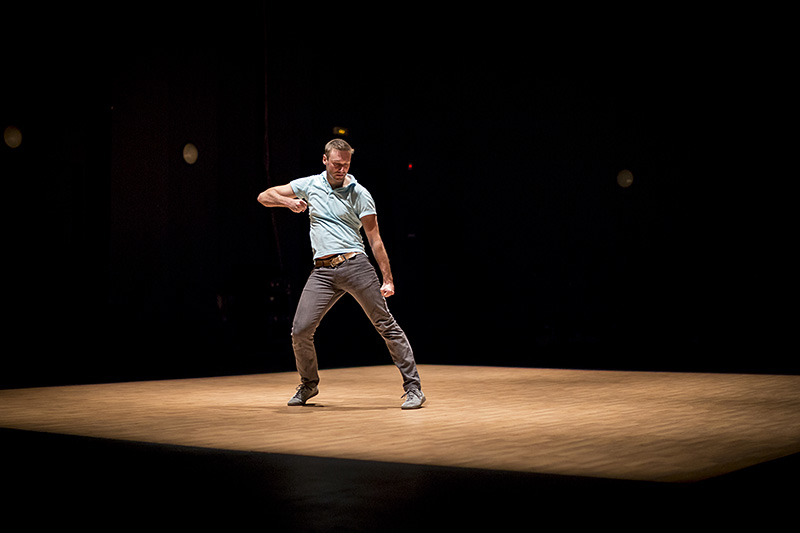 On Monday, October 12, 2015 the second premiere of Dogtown was held in the Ponec Theatre. It was originally created for the Prague Pride Festival and was performed on Shooters Island. This work was put on the stage again at the beginning of the 15th season of the Ponec Theatre in the lobby of the metro station Florenc. Although the audience could see Dogtown for the third time, this was the first time in the theatre with all amenities and facilities. And, perhaps, the proverb “all things come to him who waits” holds true.
In a way, the theatre is a conservative area traditionally divided into a stage and an auditorium; however, it has its strong spells in the technical background and proper lighting. In today´s fragmented world, where one has to do at least twenty things at the same time, all this together makes it easier to re-focus on the only thing that a spectator of any artistic work should observe – on the work as such.
Nadar Rosan´s (the Israeli choreographer) testimony about the desire to resist group thinking and current concerns about standing out from the crowd was just non-expansive. Only the theatre space gave it an opportunity to emerge. The duet of the proportionally different men (Martin Šalanda, Roman Zotov) sometimes gives the impression of disunity of the individual who wages an inner fight with his conscience that orders him to rebel against behaviour and thinking of the surrounding society. It deals with topics such as refugees, homosexuality or drugs in spoken hints. The man wants to be heard, but instead of him proudly proclaiming the truth through the direct confrontation with the audience, he lies on the floor crouching, embracing the microphone and whispering almost inaudibly. His own indecision is expressed through the nervous sliding of his hand on the belly and through characteristic movements that are characterized by a certain sudden weakness. We can see the crucial action at the very end, where appears a furious cameraman who tries to capture even the most intimate details. There are infinitely repeating one-minute motion sequences of both men when the cameraman shows up. At the second premiere the performances of both artists seemed concentrated and convincing, even though the topic could be elaborated in greater extremes.
Michal Záhora´s new face in Devoid
On Monday, October 12, 2015 the second premiere of Dogtown was held in the Ponec Theatre. It was originally created for the Prague Pride Festival and was performed on Shooters Island. This work was put on the stage again at the beginning of the 15th season of the Ponec Theatre in the lobby of the metro station Florenc. Although the audience could see Dogtown for the third time, this was the first time in the theatre with all amenities and facilities. And, perhaps, the proverb “all things come to him who waits” holds true.
In a way, the theatre is a conservative area traditionally divided into a stage and an auditorium; however, it has its strong spells in the technical background and proper lighting. In today´s fragmented world, where one has to do at least twenty things at the same time, all this together makes it easier to re-focus on the only thing that a spectator of any artistic work should observe – on the work as such.
Nadar Rosan´s (the Israeli choreographer) testimony about the desire to resist group thinking and current concerns about standing out from the crowd was just non-expansive. Only the theatre space gave it an opportunity to emerge. The duet of the proportionally different men (Martin Šalanda, Roman Zotov) sometimes gives the impression of disunity of the individual who wages an inner fight with his conscience that orders him to rebel against behaviour and thinking of the surrounding society. It deals with topics such as refugees, homosexuality or drugs in spoken hints. The man wants to be heard, but instead of him proudly proclaiming the truth through the direct confrontation with the audience, he lies on the floor crouching, embracing the microphone and whispering almost inaudibly. His own indecision is expressed through the nervous sliding of his hand on the belly and through characteristic movements that are characterized by a certain sudden weakness. We can see the crucial action at the very end, where appears a furious cameraman who tries to capture even the most intimate details. There are infinitely repeating one-minute motion sequences of both men when the cameraman shows up. At the second premiere the performances of both artists seemed concentrated and convincing, even though the topic could be elaborated in greater extremes.
Michal Záhora´s new face in Devoid
 The repeat performance of Michal Záhora´s solo work called Devoid was held within the same evening. This artist, who is inseparably linked with the ensemble NANOHACH, is known not only for his dance, but also for the philosophy of his work. In Diptych he explores movements of the soul, in Orbis Pictus nature of humanity. However, in the performance Devoid, which has an abstract subtitle "being in the state of loss", he embarks on the specific waters. And he demonstrates that he is very good at this too – whether it is choreography or interpretation.
The initial entrée on Johann Sebastian Bach´s music might seem a bit unconvincing. We see the manly Záhora, who dances blithely like a child, suddenly does a jumpingjack and then catches butterflies for a while. To show kinetic exhilaration he uses worn-out motion clichés (jetés, balancé, etc.). The purpose of it is to provoke a contrast with what comes up. It is a hard fall into the reality, into dark corners of human souls that are opened through intimate letters which are written very openly. However, the letters cannot reach the recipient, since he is dead, far away, or there is a lack of the sender´s courage to tell him everything... The content of the individual letters is sometimes read out as a whole and sometimes in solitary fragmented sentences that make no sense. In all the letters you can feel the urgency, which is expressed by Záhora´s movement. He often embarks on civil gestures that are repeated in some kind of loops. He successfully melts emotions coming out from the letters into motion shapes. You can feel reluctance, despair and hopelessness, and sometimes there is a feeling of emptiness which affects the individual forever. Also the stories are of course very strong; they follow each other, but they also overlap one another and they deposit in layers. Sad fate and human mistakes, which cannot be remedied, are thematically connected with family and loved ones. Sometimes Záhora moves fast, on the contrary, sometimes he stops moving only using subtle gestures. They are really effective due to the lighting which almost disappears and obscures the scene at the same time. There is a square on the floor, which clearly defines the area within which Záhora moves; it is evidently a symbol of life hardships from which you cannot escape. Although Záhora tries to run out of it, the centripetal force always pulls him back. In short, there are things that we have to bear forever. The details, such as a civil suit or the fact that Záhora enters the stage after sitting among the spectators, contribute to the compactness and concreteness of the work.
The repeat performance of Michal Záhora´s solo work called Devoid was held within the same evening. This artist, who is inseparably linked with the ensemble NANOHACH, is known not only for his dance, but also for the philosophy of his work. In Diptych he explores movements of the soul, in Orbis Pictus nature of humanity. However, in the performance Devoid, which has an abstract subtitle "being in the state of loss", he embarks on the specific waters. And he demonstrates that he is very good at this too – whether it is choreography or interpretation.
The initial entrée on Johann Sebastian Bach´s music might seem a bit unconvincing. We see the manly Záhora, who dances blithely like a child, suddenly does a jumpingjack and then catches butterflies for a while. To show kinetic exhilaration he uses worn-out motion clichés (jetés, balancé, etc.). The purpose of it is to provoke a contrast with what comes up. It is a hard fall into the reality, into dark corners of human souls that are opened through intimate letters which are written very openly. However, the letters cannot reach the recipient, since he is dead, far away, or there is a lack of the sender´s courage to tell him everything... The content of the individual letters is sometimes read out as a whole and sometimes in solitary fragmented sentences that make no sense. In all the letters you can feel the urgency, which is expressed by Záhora´s movement. He often embarks on civil gestures that are repeated in some kind of loops. He successfully melts emotions coming out from the letters into motion shapes. You can feel reluctance, despair and hopelessness, and sometimes there is a feeling of emptiness which affects the individual forever. Also the stories are of course very strong; they follow each other, but they also overlap one another and they deposit in layers. Sad fate and human mistakes, which cannot be remedied, are thematically connected with family and loved ones. Sometimes Záhora moves fast, on the contrary, sometimes he stops moving only using subtle gestures. They are really effective due to the lighting which almost disappears and obscures the scene at the same time. There is a square on the floor, which clearly defines the area within which Záhora moves; it is evidently a symbol of life hardships from which you cannot escape. Although Záhora tries to run out of it, the centripetal force always pulls him back. In short, there are things that we have to bear forever. The details, such as a civil suit or the fact that Záhora enters the stage after sitting among the spectators, contribute to the compactness and concreteness of the work.If you think that Michal Záhora’s work is connected to certain stereotypes, you will be certainly surprised by Devoid in a pleasant way. It is human, understandable and touching. Written from the performance on 12 October 2015 in the Ponec Theatre. Dogtown Motive, choreography and text: Nadar Rosano
Production, dance and text: Martin Šalanda and Roman Zotov
Light design: Pavla Beranová
Sound: Roy Hasson
Photographer: Vojta Brtnický
Curator of the project and production: Honza Malík
Producer: Prague Pride, z. s.
Co-producer: Tanec Praha / PONEC – divadlo pro tanec Devoid Motive, choreography and dance: Michal Záhora
Creative cooperation: Tereza Krčálová
Music: Carlo Natoli
Music and sound editing: Philippe Leforestier
Voices: Honza Malík a Howie Lotker Light design: Robert Štěpánek
Producer: Honza Malík & NANOHACH, z. s. / association
Project volunteer: Adéla Kaderová
International manager: Lenka Flory Translation: Anna Würtherlová




Josef Bartos
Thank you for your thoughts. One got stuck in my mind – that passion makes us different from AI. Just yesterday I read…I am a dance critic. I am a member of an endangered species